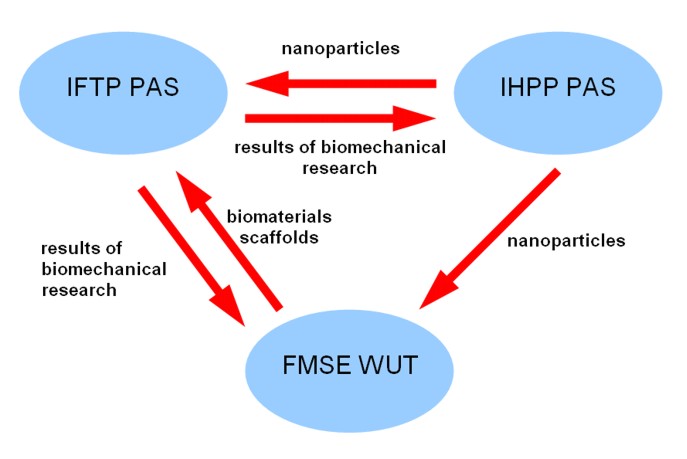There are no all translations available.
The Centre for Bionanomaterials
The Centre is a common initiative of three research entities:
- The Institute of High Pressure Physics of the Polish Academy of Sciences (IWC PAN)
- The Institute of Fundamental Technological Research of the Polish Academy of Sciences (IPPT PAN)
- The Faculty of Materials Science and Engineering of the Warsaw University of Technology (FMSE)
Each of the entities is responsible for creating one laboratory:
- IWC - Laboratory for Nanostructures for Photonics and Medicine,
- IPPT - Laboratory for Modelling and Imaging in Biomechanics,
- FMSE - Laboratory for the Production and Characterizing of Biomaterials
The Centre for Bionanomaterials will be an interdisciplinary centre, in which the competences in the field of materials, nanomaterials, mechanics, biophysics and biochemistry will be combined with the present on the premises strong competences concerning experimental medicine, biomedicine and molecular chemistry. The diagram below presents the mutual functional connections of the CB laboratories.
The leading common project of the 3 entities will be developing a nanohydroxylapatite of a special chemical structure and nanostructure serving as a promoter of the growth of the bone tissue. The techniques of the pressure synthesis allow to obtain a material, which, according to the most recent reports, undergoes resorption in the organism providing material for the bone growth. In the IPPT PAN computer simulations of this process will be conducted and in the FMSE WUT comprehensive structural and mechanical testing will be conducted, and, in co-operation with the MUW - preclinical testing.
Diagram: Co-operation between the CB laboratories

In the Laboratory for Nanostructures for Photonics and Medicine nanoparticles of the third generation will be produced, i.e. nanostructures allowing to identify and disable pathogens. Antibacterial nanostructures and functional implants will also be produced.
The research programme of the laboratory complies with the European Technology Platform on NanoMedicine strategy and the Polish Nanotechnology Platform. The European Nanomedicine Platform identified 3 strategic fields: nanophotnics-based diagnostics, regenerative medicine and targeted drug delivery.
The main aim of the laboratory's research is the application of nanoparticles of the third generation for the above purposes. Third-generation nanoparticles are nanostructures consisting of nanoparticles serving as supporting structure, surface layers of nanometric thickness and molecules or elements giving the structure the required functions. Such particles can be covered with appropriate molecules, which join determined proteins. Applications: biosensors, biomarkers, components in tissue - primarily bone tissue - regeneration, scintillators for medical diagnostics, marking objects, biomaterials, drugs. Antibacterial and antifungal properties.
In the preclinical testing, in compliance with the CePT main programme line, nanoparticles will be tested as 'in-vitro' markers. The suitable composition of nanoparticles may combine different functions: magnetic, optical, electrical. It can be used for marking particular tissues or substances in a way that makes them distinguishable and cannot be falsified, like many drugs.
The laboratory will be the nanostructure experimental production centre, specializing in doping, functionalization and composing materials out of them.
The research programme will cause the integration of 3 strategic directions of research of the Institute of High Pressure Physics of the Polish Academy of Sciences: optoelectronics with a big participation of photonics, nanotechnology and biochemistry. The three research teams will support each other and the results of the work will have a multiplied impact on the society and economy through the strengthening of the co-operation with the CePT partners, especially with the Faculty of Materials Science and Engineering of the Warsaw University of Technology, The Institute of Fundamental Technological Research of the Polish Academy of Sciences, the Medical University of Warsaw, the Faculty of Chemistry of the Warsaw University. The Institute of Physics PAS will be also invited to co-operation.
In the Laboratory for Modelling and Imaging in Biomechanics (IPPT PAN) the following research will be conducted: concerning the application of ultrasounds in imaging medical diagnostics talking into consideration contrasts and the therapeutic effects of heat related to heat emission and cavitation, modelling and testing the processes and changes in the tissue structure caused by the interaction with biomaterials and the influence of physical / mechanical factors as well as the application of nanoparticles in the systems of targeted drug release.
Acoustic microscopy enables the examination of cells, both alive and fixed ones. The images obtained with mechanical waves allow to follow the processes connected with the motoric activity of cells and to examine the condition of cells and their reaction to external stimuli. They enable both conducting fundamental research in cellular biology and testing the pharmacological means on living organisms. The techniques of acoustic microscopy allow also to determine the mechanical properties of cells and tissues. Sound waves are used for therapeutic purposes in various areas. The treatment level of the biological effects caused by the interaction of ultrasound waves depends primarily on the level of exposure. The main objective of the team of the IFTP researchers in the area of the therapeutic applications of ultrasounds will be conducting research and developing new, optimal conditions of the work of the source, described by its frequency, amplification of the beam and the exposure time, which offer the maximum efficiency of treatment for particular therapeutic applications.
The development of a miniaturized version of the system for the analysis of nucleic acids with the LOC microsystems will consist in the construction of microchannels and developing the conditions of nucleic acids electrophoresis in miniaturized geometry. The device will allow for the acceleration and automatization of the process of nucleic acid electrophoresis in order to detect point changes in the DNA sequence. The project will allow to build an integrated system of micro flows for the DNA analysis. The main objectives of the project are the identification of the physico-chemical parameters enabling to control the process of the DNA thread migration in the system of channels of the millimetres size and their optimizing in order to accelerate this process maintaining its high repetitiveness and developing the methods of optical detection of the DNA thread location in the channel with the method of fluorescence. The conducted research aim to select the fluorescent stains and lighting systems (LED diodes) so it will allow in the future to integrate the whole on a single silicone cube of the LOC system.
The development of a system of controlled release of healing substances from biodegradable polymers introduced into the examined biological microprobe structures based on nanofibres and constructing bio-frames for tissue regeneration aims to create a new method of producing basic materials, whose testing and application are the ultimate objective of the programme. At the same time, work will be conducted on the application of protein nanofibres as two-dimensional probes for the detection of membrane defects of cells. An important part of the project will be producing the systems of drug release from biodegradable polymers produced in the technological process of electroweaving. Their huge advantage is big gas and body fluid permeability. Nanofibres have also all the advantages of drug releasing characteristic of nanoparticles (such as releasing DNA in cells). The objective of the project will be creating the methodology of the bone tissue regeneration (implants) and skin tissues (burns, defects).
Research into the processes taking place in the bone tissue as a result of the interactions with biomaterials and various physical signals, based on tissue cultures and (in co-operation with other institutes) on experiments on animals will also be conducted. The experimental research will be supported by mathematical modelling and computer simulations of the processes taking place on the tissue-biomaterial border. Special emphasis will be put on taking into account simultaneous processes of bioresorption and biodegradation of biomaterials and the synthesis and resorption of tissue and the related reconstruction of its microstructure. The results of the experimental research and developing mathematical and computer models will enable to design improved biomaterials and implants for orthopedy.
The influence of the mechanical properties of biomaterials , the surface structure contacting the tissue and the microstructure of the very biomaterial (e.g. scaffolds and bone replacement material) on the processes taking place in the tissue are a significant problem. Research is planned for implantology and breeding the cellular interaction of biomaterials with bone and cartilage cells and the influence of its parameters describing the topological and mechanical characteristics of such materials on the processes of forming , healing and reconstruction of tissue.
The mechanical condition in the bone tissue is one of the main factors stimulating the process of healing and reconstruction. Experimental and theoretical research into the influence of various mechanical signals and other physical interactions on the said processes and developing adequate mathematical and computer models should, in the future, lead to the development of improved medical therapies and more intelligent third-generation materials increasing the bone-constructing activity of cells.










